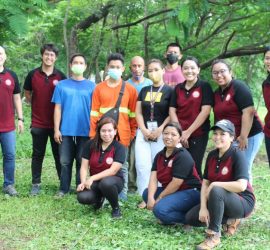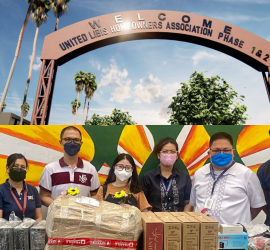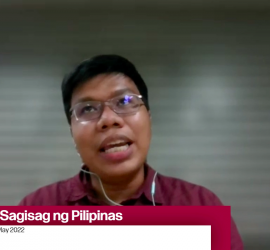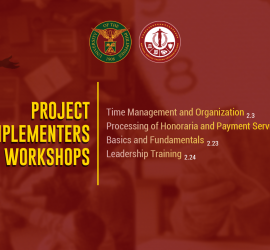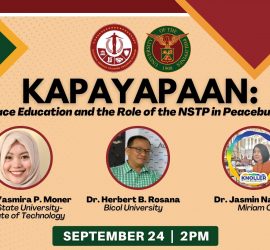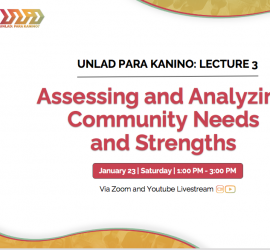The NSTP Diliman Office with the assistance of the Campus Maintenance Office (CMO) launched a tree planting activity on the grounds of the UP Diliman College of Mass Communication on June 6, 2022. CMO Director Perlita Raña designated the tree planting site and provided the guidelines for tree planting in UP Diliman. Ms. Olivia B. Indaya, Landscaping Supervisor, supervised the session on-site. Memorandum No. CAS-12-038 states that the seedlings to be planted must be endemic and indigenous species to firmly discontinue the use of exotic species. Exotic species are invasive that disrupt and harm the existing ecosystem. Narra seedlings were planted in compliance with the memorandum and were procured from the Department of Environment and Natural Resources National Capital Region (DENR-NCR). The tree planting initiative is part of the NSTP Diliman Office’s Luntian at Pula (LuPA) advocacy, a project encouraging people especially NSTP students to take action in protecting and conserving our environment. LuPA is geared towards transcending from tree-planting activities to promote environmental awareness and embark on environment-friendly practices that people can embrace as part of their lives. LuPA is guided by the NSTP Common Module on Environmental Protection and RA 10176 or the “Arbor Day Act of 2012”. Under this law, all able-bodied citizens of the Philippines who are at least 12 years of age are required to plant one (1) tree every year. By Anthony Bagano Jr.
ACTIVITIES
HELPING A GROWING COMMUNITY Over the past 36 years, Sitio Libis in Valenzuela City was once an informal settlers community. The community did not have legal rights to build structures and buildings till the Land Acquisition Project in 2010. Now, Sitio Libis can finally build structures that will help with the development of its community. In partnership with the Technical Assistance Movement for People and Environment, Inc. (TAMPEI), the CTWS class under the College of Architecture (COA) helped with the design of the boundary arch of Sitio Libis as a marker for the community. The Sitio Libis community thanked the CWTS class for their efforts, as the boundary arch symbolizes their growing community. PROJECT KATARUNGAN Project Katarungan was an initiative by the NSTP-College of Social Sciences & Philosophy (CSSP) to assist the persons deprived of liberty or PDL with their online hearings and online classes by contributing laptops and other devices. Last June 21, the NSTP classes: CWTS 2 CSSP MJKL (Prof. Daniel Mabazza), CWTS 2 CSSP MKLN1 (Asst. Prof. Jairus Diesta Espiritu), and CWTS 2 CSSP MXY (Asst. Prof. Marielle Marcaida) turned over four sets of computers (with tables and chairs) to Tanglaw Pag-asa, Bulacan’s youth rehabilitation center. As a token of appreciation, they were given flower pens hand-made by their youth. NSTP-CSSP Coordinator, Asst. Prof. Jairus Espiritu, shared the activity in his FB account and expressed his thoughts in teaching NSTP. Asst. Prof. Espiritu said “teaching NSTP reminded me of our shared humanity–how all of us are in need of each other’s help. And I do think it is from this shared humanity that our civic duties arise. We are responsible for one another because we are in each other.” By Ma. Regina Valerio
The UP System NSTP Council has been formally institutionalized through Administrative Order No. PDLC 22-42 signed on May 13, 2022. Under the Office of the Vice-President of Academic Affairs, the council holds the primary responsibility in supervising the implementation of the NSTP Law (Republic Act No. 9163) and its Implementing Rules and Regulations (IRR) in the UP System. In addition, the Council shall also recommend, promote, and coordinate System-wide public service initiatives to mobilize NSTP students, handlers, and teachers in the university. The Council is expected to hold regular meetings to determine shared NSTP directions and initiatives and resolve issues in implementing the NSTP Law common to the UP Constituent Universities (CUs). Dagyaw: Developing the NSTP UP System Implementation Dagyaw recommended the constitution of the UP System NSTP Council, its roles and responsibilities to the Office of the President. Dagyaw is an informal group of NSTP directors/coordinators of the different CUs. Assistant Vice President for Academic Affairs Richard Philip A. Gonzalo supported the initiative. The current members of Dagyaw are Asst. Prof. Jose Mathew Luga (UP Baguio), NSTP Director Dennis F. Quilala (NSTP Diliman Office), NSTP Director and Assistant to the Vice Chancellor of Academic Affairs Roselle V. Collado (UP Los Baños), NSTP Director Astrid Korina G. Gianan (UP Manila), OIC Office of Extension and Community Services Cleto L. Nanola (UP Mindanao), Department of Human Kinetics Chair Erwin E. Protacio (UP Mindanao) Mr. Neil Ebate (UP Mindanao), NSTP Coordinator Rhonna Marie R. Vereña (UP Open University), Asst. Prof. Marie-Sol Hidalgo (UP Open University), Ms. Louanne Mae Calipayan (UP Open University), NSTP Director Nathaniel G. Samson (UP Visayas). The NSTP Diliman Office serves as the secretariat of Dagyaw with Dr. Likha Minimo (Deputy Director), Ms. Maritess Bingco (Administrative Officer), Ms. Paula Adriano (Junior Office Associate), Ms. Carina Merin (Senior Research Associate for Research and Development), Ms. Regina Valerio (Senior Project Assistant for Training and Education), Ms. Anne Languayan (Senior Project Associate for NSRC), and Mr. Anthony Bagano Jr (Senior Project Assistant for Project Management). Former members of Dagyaw include Asst. Prof. Shekinah Dorelle P. Queri (UP Baguio) and Asst. Prof. Darius […]
The NSTP Diliman Office’s award-winning radio program, Serbisyong Tatak UP, went live on DZUP 1602’s Facebook Live on May 16, 2022 with the episode entitled, “WAGAYWAY: Sagisag ng Pilipinas”. Klasmeyts Gian Librojo and Carl Sayat talked about the history of the Philippine Flag and the Heraldic Code of the Philippines with the History Researcher from the National Historical Commission of the Philippines (NHCP), Mr. Mark Reinere Policarpio. Mr. Policarpio took the viewers to a History class to help them remember how the Philippine flag was created and what is the importance of the Heraldic Code. He then shared with the NSTP students and the youth that they can help spread knowledge about the Heraldic Code and patriotism through community engagements and volunteer activities. Serbisyong Tatak UP airs every 1st & 3rd Monday of the month, from 11:00 am to 12:00 pm. You can replay our past episodes at nstp.upd.edu.ph/stup. For announcements, please like and follow the Serbisyong Tatak UP Facebook page, faceboo.com/serbisyongtatakup. By Ma. Regina Valerio
In February 2022, the NSTP Diliman Office spearheaded the Project Implementers Workshop Series aimed to equip project implementers with the fundamental project management skills that are essential in carrying out their respective projects amidst the COVID pandemic via Zoom. Participants of the workshop were from the NSTP Diliman Office and Office of FIeld Activities. The workshop series was composed of four topics on Basics and Fundamentals, Time Management and Organization, Processing of Honoraria and Payment Services, and Leadership Training. Professor Joseph L. Torrecampo (Polytechnic University of the Philippines), Ms. Ma. Ellaine May S. Jaramilla (University of the Philippines Diliman), Mr. Erwin Donavan S. Ong (Nokia Solutions and Networks Wroclaw Inc.), and Ms. Loridel M. Manalo (Every Nation Campus Philippines) were invited guest speakers who shared their expertise. By Anthony Bagano Jr.
In commemoration of the National Peace Consciousness Month held every September, the NSTP Diliman Office organized a webinar entitled “Kapayapaan: Peace Education and the Role of the NSTP in Peacebuilding” last September 24, via Zoom and YouTube Live. The webinar aimed to introduce peace education—what it is and how it is contextualized in Philippine universities—as a new common module topic for NSTP. Together with staunch peace advocates Dr. Jasmin Nario-Galace (Miriam College), Dr. Herbert B. Rosana (Bicol University), and Asst. Prof. Yasmira Moner (Mindanao State University – Iligan Institute of Technology), the webinar explored potential pathways to promote peacebuilding through peace education in Philippine universities and colleges. 480 participants entered the Zoom space, and almost 15,000 viewers were able to watch the engagement through YouTube Live. Bringing together participants from all over the country, the webinar shed light on how peace education is valuable in the peacebuilding process. It opened a wide range of discussion about its implementation: from the provision of training and support for teachers despite not being peace educators, to the challenge of possible peacebuilding projects during this remote and blended learning period. Dr. Ma. Theresa Payongayong, Vice Chancellor for the Academic Affairs of the University of the Philippines Diliman, formally opened the event welcoming the speakers and the thousands of faculty and students representing various state universities and colleges (SUCs) in the country. She shared that UP Diliman, consistent with UP’s mandate to become a public service university, has provided supplementary knowledge products and instructional materials for various academic programs. As she had said, “For the past 18 months of adapting and adjusting to the new normal, peace is very much needed… and we are very much looking forward to ‘Healing as One Nation and Recovering as a Better Generation,’ as the theme for this year’s National Peace Consciousness Month.” NSTP Diliman Office Director Asst. Prof. Dennis Quilala framed the peace education within the NSTP while underscoring the importance of teaching peace within the university. Setting the agenda for the webinar, Asst. Prof. Quilala also provided an overview of the Tatak UPD NSTP Common Module Topics […]
The final webinar of the series, UNLAD: Para kanino? Talakayan ukol sa pagbubuo ng mga proyektong pang-kaunlaran ng komunidad, explored the fundamentals of Preparing and Writing Project Proposals. The session’s speaker was Assistant Professor Devralin T. Lagos from the College of Social Work and Community Development, University of the Philippines Diliman. Just like with the previous sessions, this webinar is aimed at ensuring that all processes involved from the conceptualization until evaluation of projects in the community are anchored upon the principles of a people-centered development. It emphasized the importance of community organizing. Project development practitioners need to conduct iterative and joint writing workshops and to assign community workers as “facilitators of development planning and proposal development” that “handover the stick” to the community. The speaker reiterated that the people in the communities are not just “add-ons.” They should be the centre of the project. To be anchored in the principles of people-centred development means to undertake the questions “Kaninong plano at pangarap ang dapat maisalamin ng project proposal?” and “Sino ang dapat magsulat ng proposal?” With conviction, the speaker answered that her bias was that the community members should be writing the proposal. In the latter part of her presentation, she cited an example where a community wrote a paper abstract and even presented it at an international conference proving her point that community members can write a project proposal. However, she acknowledged the prevalence of instances where the office or the students themselves write the proposal. Most importantly, she reminded everyone that it is still possible to engage in participatory methods when writing proposals. The speaker cited an example that reinforced the mentioned key points. A fisherfolk community harvests and sells shellfish. This community is prone to red tide, resulting in loss of income and extreme hunger and poverty. The community had done community planning workshops concerning their situation due to the red tide. They analyzed their progression of vulnerability and progression of safety. They realized that their lack of savings even without red tide causes extreme poverty. Poverty is the lack of access to resources of the […]
As the webinar series continued on its fourth run, its focus now shifted to Development, Implementation, and Evaluation of Participatory Projects. The first speaker for this webinar, Sir Karl Arvin Hapal from the Department of Community Development, College of Social Work and Development at the University of the Philippines Diliman, explained that the concepts he will be discussing are based on the concept of decolonization of development. As he said, this means that the development is being brought back to the people. Prof Hapal’s first key point is about the conventional practices and methods that are used for participatory project development, implementation, monitoring, and evaluation. These include Logical Framework, Theory of Change, and SWOT Analysis. A logical framework is used to assess the contribution of small activities to the bigger objective. Theory of Change includes if-and-then-statements (if C is done, E will be the result) to assess a project. SWOT Analysis involves looking into the strengths, weaknesses, opportunities, and threats of a project. Prof Hapal claimed these methods as logic and evidence-based but he also claimed that these are not without limitations. He expounded by saying that these methods have philosophical biases. It was developed through the lenses of business and public administration – through managers and administrators. Due to their origin, these methods were subjected to top-down tendencies. Moreover, the conventional methods perceive a project life cycle like that of a tree. It is linear. Prof. Hapal contradicted this and said that a project life cycle is, in reality, not linear. He challenged the participants to reexamine the planning, implementation, and evaluation of projects to make them aligned with the principles of people-centred development. By sharing an example based on his experience, Prof Hapal discussed how the reexamination is done. He mentioned the social enterprise of Maigting na Samahan ng Panlipunang Negosyante or Igting from Towerville, a relocation site in San Jose Del Monte Bulacan. There are three key points on how Igting was able to sustain its social enterprise. First was the “plano vs kolektibong pangarap at shared values.” This indicates that Igting focused more on affirming their […]
The third of the five webinars for the series UNLAD: Para kanino? Talakayan ukol sa pagbubuo ng mga proyektong pang-kaunlaran ng komunidad, which was held through the Zoom platform and YouTube live reached more than ninety (90) participants. This webinar revolved around the topic of assessment and analysis of the needs and strengths of the community. Asst. Prof. Paul Edward Muego from the College of Social Welfare and Community Development started the discussion by emphasizing that, “mahalaga pag pinag-uusapan natin [ang] assessment at analysis of community needs and strengths ay dapat nakatuon ito sa pagkamit ng mga pangkalahatan at partikular na layunin ng people-centred development.” According to him, these objectives include promoting the welfare and well-being of the people, capacity building, strengthening communities’ participation in various organization efforts, promoting learning, increasing self-efficacy and confidence in self and community efforts, and lastly, assessment and analysis of needs and strengths should encourage fellowship. Assessing and analysing the needs and strengths of communities should not be disintegrated with the concept of community organizing, Prof Muego pointed out. Through community organizing, the organizers can collect data and information about the community which will reveal the needs and strengths of the community. He further highlighted that the organizers should only assist the people in doing such instead of imposing instructions to the community. He then proceeded in outlining the processes involved in participatory project development and management and made the participants know where assessment and analysis of needs and strengths come into play. He mentioned that knowledge of the needs and strengths of the community will aid in identifying which projects are feasible and should be implemented. Why do people need to play a major role in the assessment and analysis of needs and strengths? Sir Muego answered this by saying that it is to make sure that the needs and strengths came from the community itself. This will verify the identified needs and strengths because they came first hand from the people. Moreover, if the assessment and analysis are done by the community, their understanding of their lives and their situation will deepen and […]
UNLAD: Para kanino? Talakayan ukol sa pagbubuo ng mga proyektong pang-kaunlaran ng komunidad continues its run, as it featured the topic Steps and Methods in Community Organizing on January 16, 2020. It was attended by ninety-five (95) participants. While the first webinar circulated around people-centred development this session shifted its focus on community organizing. The first speaker in this webinar is Professor Victor Obedicen. Professor Obedicen teaches both undergraduate and graduate students in various courses such as Community Organizing, Community Planning, and Community-based Disaster Risk and Reduction Management in the College of Social Work and Community Development at the University of the Philippines Diliman. The resource person reminded everyone that community organizing can take several forms and that it can come from different points of view. Moreover, the speaker clarified that the discussions will focus on his institution’s point of view. Community organizing is not just forming mere organizations rather is the formation of organizations of the people. The center of community organizing is the people. It is a process that strengthens the capabilities and skills of people in the community to identify, face, and solve their problems. Since it revolves around people, one of the goals of community organizing is ensuring that people are aware of their situation and their potentials and resources to achieve a better quality of life. Community organizing aims to develop mechanisms and structures for upholding and protecting people’s rights. These awareness and mechanisms must reflect on actions that will contribute to changing the community. The speaker continued by explaining why organizing and organizations are important. The unity of people creates power and strength. Organizations mean more people are addressing and thinking about solutions for the problems. They also have mechanisms for advocacy and networking. Another importance of organizing is that organizations, when functional and strong, tend to last longer. Lastly, they serve as a vessel in accomplishing project development plans for the community. Prof. Victor mentioned that in community organizing there are non-negotiables or ideas and principles that are not up for debate but rather accepted as truth. These include (1) trusting the people, […]

